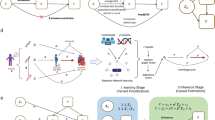Summary
Many studies have shown that segregating quantitative trait loci (QTL) can be detected via linkage to genetic markers. Power to detect a QTL effect on the trait mean as a function of the number of individuals genotyped for the marker is increased by selectively genotyping individuals with extreme values for the quantitative trait. Computer simulations were employed to study the effect of various sampling strategies on the statistical power to detect QTL variance effects. If only individuals with extreme phenotypes for the quantitative trait are selected for genotyping, then power to detect a variance effect is less than by random sampling. If 0.2 of the total number of individuals genotyped are selected from the center of the distribution, then power to detect a variance effect is equal to that obtained with random selection. Power to detect a variance effect was maximum when 0.2 to 0.5 of the individuals selected for genotyping were selected from the tails of the distribution and the remainder from the center.
Similar content being viewed by others
References
Asins MJ, Carbonell EA (1988) Detection of linkage between restriction fragment length polymorphisms and quantitative traits. Theor Appl Genet 76:623–626
Beckmann JS, Soller M (1983) Restriction fragment length polymorphisms in genetic improvement: methodologies, mapping and costs. Theor Appl Genet 67:35–43
Edwards MD, Stuber CW, Wendel JF (1987) Molecular-marker-facilitated investigations of quantitative trait loci in maize. I. Numbers, genomic distribution and types of gene action. Genetics 116:113–125
Jeffreys AJ, Wilson V, Thein SL (1985) Hypervariable “minisatellite” regions in human DNA. Nature 314:67–72
Kashi Y, Iraqi F, Tikochinsky Y, Ruzitsky B, Nave A, Beckmann JS, Friedmann A, Soller M, Gruenbaum Y (1990) (TG)n uncovers a sex-specific hybridization pattern in cattle. Genomics 7:31–36
Kashi Y, Soller M, Hallerman EM, Beckmann JS (1986) Restriction fragment length polymorphisms in dairy cattle genetic improvement. Proc 3rd World Cong Genet Appl Livest Prod 12:57–63
Knapp SJ, Bridges WC, Birkes D (1990) Quasi-Mendelian analyses of quantitative trait loci using molecular marker linkage maps. Theor Appl Genet 79:583–592
Lander ES, Botstein D (1989) Mapping Mendelian factors underlying quantitative traits using RFLP linkage maps. Genetics 121:185–199
Lebowitz RJ, Soller M, Beckmann JS (1987) Trait-based analyses for the detection of linkage between marker loci and quantitative trait loci in crosses between inbred lines. Theor Appl Genet 73:556–562
Litt M, Luty JA (1989) A hypervariable microsatellite revealed by in vitro amplification of a dinucleotide repeat within the cardiac muscle actin gene. Am J Hum Genet 44:397–401
Paterson AH, Lander ES, Hewitt JD, Peterson S, Lincoln SE, Tanksley SD (1988) Resolution of quantiative traits into Mendelian factors by using a complete linkage map of restriction fragment length polymorphisms. Nature 335:721–726
SAS Institute Inc (1985) SAS users' guide: basics, version 5. SAS Institute Inc, Cary, N.C.
Sax K (1923) The association of size differences with seed-coat pattern and pigmentation in Phaseolus vulgaris. Genetics 8:552–560
Soller M (1990) Genetic mapping of the bovine genome using DNA-level markers with particular attention to loci affecting quantitative traits of economic importance. J Dairy Sci 73:2628–2646
Soller M, Beckmann JS (1983) Genetic polymorphisms in varietal identification and genetic improvement. Theor Appl Genet 67:25–33
Stuber CW, Edwards MD, Wendel JF (1987) Molecular marker facilitated investigations of quantitative trait loci. II. Factors influencing yield and its component traits. Crop Sci 27:639–648
Tanksley SD, Medina-Filho H, Rick CM (1982) Use of naturally-occurring enzyme variation to detect and map genes controlling quantitative traits in an interspecific backcross of tomato. Heredity 49:11–25
Weber JL, May PE (1989) Abundant class of Human DNA polymorphisms which can be typed using the polymerase chain reaction. Am J Hum Genet 44:388–396
Weller JI (1986) Maximum likelihood techniques for the mapping and analysis of quantitative trait loci with the aid of genetic markers. Biometrics 42:627–640
Weller JI (1987) Mapping and analysis of quantitative trait loci in Lycopersicon. Heredity 59:413–421
Weller JI, Soller M, Brody T (1988) Linkage analysis of quantitative traits in an Interspecific cross of tomato (Lycopersicon esculentum and Lycopersicon pimpinellifolium) by means of genetic markers. Genetics 118:329–339
Weller JI, Kashi Y, Soller M (1990) Estimation of sample size necessary for genetic mapping of quantitative traits in dairy cattle using genetic markers. J Dairy Sci 73:2525–2537
Zhuchenko AA, Samovol AP, Korol AB, Andryushchenko VK (1979) Linkage between loci of quantitative characters and marker loci. II. Influence of three tomato chromosomes on variability of five quantitative characters in backcross progenies. Genetika 15:672–683
Author information
Authors and Affiliations
Additional information
Communicated by D. Van Vleck
Rights and permissions
About this article
Cite this article
Weller, J.I., Wyler, A. Power of different sampling strategies to detect quantitative trait loci variance effects. Theoret. Appl. Genetics 83, 582–588 (1992). https://doi.org/10.1007/BF00226901
Received:
Accepted:
Issue Date:
DOI: https://doi.org/10.1007/BF00226901




